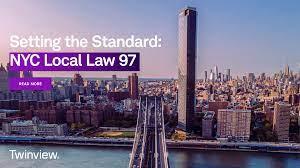As New York City moves towards a more sustainable future, Local Law 97 is playing a pivotal role in driving emissions reductions. Building owners and operators are faced with the challenge of adapting to the law's stringent emissions limits. In this article, we will explore the concept of future-proofing buildings to ensure compliance with new york city local law 97, examining strategies and technologies that can help navigate the evolving landscape of sustainability.
Understanding Local Law 97: Local Law 97 sets ambitious emissions intensity limits for buildings larger than 25,000 square feet. The law's primary goal is to reduce greenhouse gas emissions and accelerate the city's transition to a low-carbon economy. Building owners must achieve emissions reductions of 40% by 2030, with additional reductions required in subsequent years. Adapting to these limits requires a forward-thinking approach to building design, operations, and energy management.
Embracing Energy Efficiency: Energy efficiency is the cornerstone of compliance with Local Law 97. Building owners must prioritize energy-saving measures to reduce their carbon footprint. This includes upgrading HVAC systems, optimizing insulation, and implementing efficient lighting solutions. Building automation systems and advanced controls can also enhance energy efficiency by optimizing energy consumption based on occupancy and usage patterns. By embracing energy efficiency, buildings can significantly reduce emissions while realizing long-term cost savings.
Integration of Renewable Energy: To meet Local Law 97's emissions limits, building owners should consider integrating renewable energy sources into their energy portfolios. Solar panels, wind turbines, and geothermal systems offer clean, renewable power generation on-site. Off-site options, such as participation in community solar programs or purchasing renewable energy credits, can also contribute to emissions reductions. The adoption of renewable energy technologies ensures a more sustainable energy supply, reducing reliance on fossil fuels and helping to achieve compliance.
Demand Response and Flexibility: Building owners can future-proof their properties by embracing demand response programs and flexible energy management strategies. Demand response allows buildings to curtail energy usage during peak demand periods, relieving stress on the grid and avoiding the need for additional fossil fuel-based power generation. Smart building technologies can facilitate demand response initiatives by enabling automated load shedding or load shifting, optimizing energy usage without compromising comfort or operations.
Resilience and Climate Adaptation: Future-proofing buildings goes beyond emissions reductions. It also involves enhancing resilience to the impacts of climate change. Local Law 97 encourages building owners to implement resilient design features, such as backup power systems and green infrastructure elements. These measures ensure that buildings can withstand extreme weather events and maintain functionality during power outages. By prioritizing resilience, building owners can protect their assets, occupants, and the environment in the face of a changing climate.
Continuous Monitoring and Data Analytics: Monitoring energy performance and leveraging data analytics are crucial for future-proofing buildings. Building owners should invest in energy monitoring systems that provide real-time insights into energy usage, emissions, and building operations. Data analytics can identify patterns, uncover inefficiencies, and pinpoint areas for improvement. By leveraging this information, building owners can make informed decisions, optimize energy usage, and track progress towards Local Law 97 compliance.
Collaboration and Innovation: Future-proofing buildings requires collaboration and innovation within the industry. Building owners should engage with energy service providers, technology vendors, and sustainability consultants to explore new solutions, technologies, and best practices. Collaboration can lead to the development of innovative approaches, such as shared energy systems, district-level energy management, and circular economy principles. By fostering a culture of collaboration and innovation, building owners can stay ahead of evolving regulations and ensure long-term sustainability.
Conclusion: Adapting to new york city local law 97 emissions limits is a significant challenge for building owners and operators. However, by embracing energy efficiency, integrating renewable energy, implementing demand response strategies, prioritizing resilience, leveraging data analytics, and fostering collaboration and innovation, buildings can be future-proofed to meet the demands of a sustainable future. By proactively embracing these strategies, building owners not only comply with Local Law 97 but also position themselves as leaders in sustainability and resilience, contributing to a greener and more resilient New York City.


